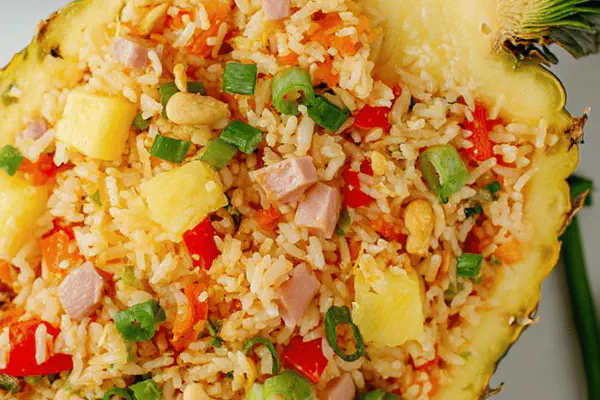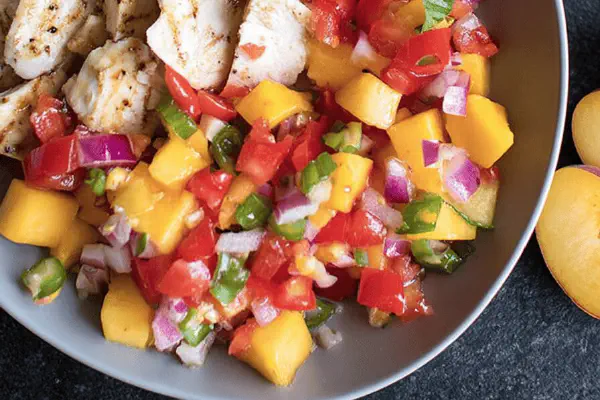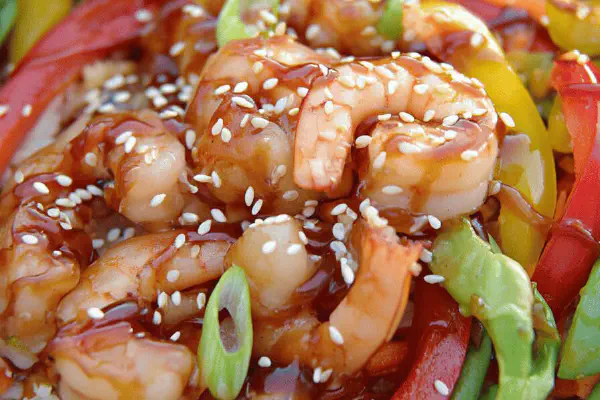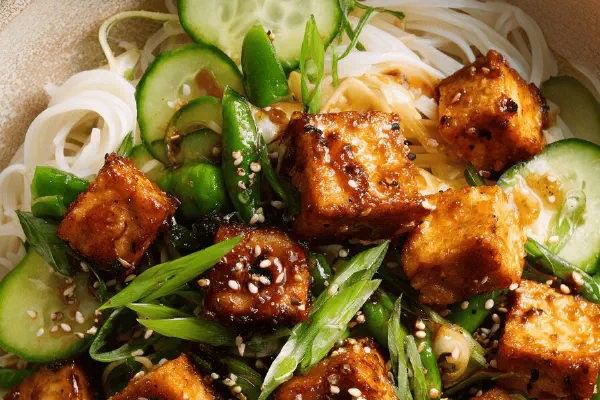Ginger Chicken Fried Rice
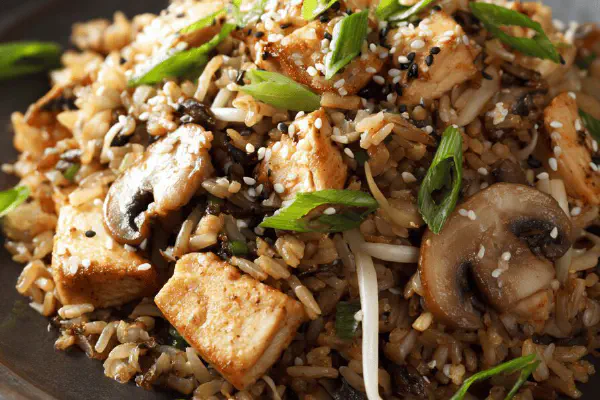
E
By Emma
Certified Culinary Professional
•
Recipe tested & approved
Simple stir-fry showing off juicy chicken cubes, fresh mushrooms, crisp bean sprouts, and just a hint of ginger, all tossed with nutty sesame oil and a tangy soy-honey glaze. Brown rice holds it all together with chew and bite, making a wholesome, no-dairy meal with a touch of crunch from sesame seeds. Quick and flexible for weeknights or brunch. No eggs, no fuss.
Prep:
15 min
Cook:
22 min
Total:
37 min
Servings:
4 servings
#Asian fusion
#stir-fry
#chicken recipes
#fried rice
#quick meals
#dairy-free
No bells here. Just quick chicken chunks married to earthy mushrooms and zingy ginger, swimming in a mix of soy, honey, and smoky sesame oil. Brown rice with chew—not that mushy stuff—rolling with fresh bean sprouts that crackle under teeth. I skip the eggs usually; nothing lost. No weird steps; straightforward ‘put it all together and watch it sing’ kinda meal. This isn’t delicate fine dining. It’s get-your-hands-dirty stir-fry that hits the right textures and smells. Learned from slipping too much soy one time—balance is everything. Crisp mushrooms before chicken, or risk them turning to rubber. Toss the rice cold, else mush city. A quick meal that does not run from flavor or texture.
Ingredients
- 350 g boneless skinless chicken thighs cut into cubes
- 50 ml tamari or soy sauce
- 20 ml maple syrup or honey
- 20 ml toasted sesame oil
- 20 ml finely grated fresh ginger
- 250 g mixed mushrooms quartered
- 30 ml vegetable or canola oil
- 480 g cooked brown rice ideally cooled
- 200 g fresh bean sprouts
- 1 thinly sliced green onion
- Black and white toasted sesame seeds optional
About the ingredients
Chicken thighs keep juiciness better than breast for frying—less dry mess. Tamari works well if you want gluten-free; else regular soy sauce or even coconut aminos for subtle sweetness. Maple syrup replaces honey easily, just a hint less sticky, more woodsy flavor. Fresh ginger’s non-negotiable here; powdered ginger jars just don’t pop. Mushrooms? I switch between cremini and white button depending on price or freshness. Vegetable oil must withstand high heat—avoid olive oil here. Brown rice is best pre-cooked and cooled, to keep grains from sticking together. Bean sprouts add freshness and crunch; skip if unavailable but expect less texture contrast. Green onions are last-minute brightness—don’t overcook.
Method
- Start with chicken cubes in a bowl. Combine tamari, maple syrup, toasted sesame oil, and ginger separately. Pull out 20 ml of this liquid, toss with chicken to marinate briefly, 5-10 minutes max. Reserve rest of sauce for later.
- Heat half the vegetable oil over very high heat in a large nonstick skillet. Mushrooms go in first; sizzle until nicely browned, releasing earthiness but not soggy. Season with salt and pepper. Once edges crisp, scoop out; keep plate nearby.
- Same pan, add remaining oil. Dump in chicken, spread thin so pieces get caramelized crust, maybe 7-9 minutes. Stir only after firm edges form; watch juices clear but don't dry out.
- Return mushrooms in, mix in cooked brown rice—day-old is best, so grains separate. Toss aggressively to break up clumps. Bean sprouts and green onion follow, give fresh crunch and brightness. Pour in reserved sauce, toss hard to coat everything evenly, heat through until aroma hits peak pot-pouring moment.
- Taste, adjust with salt or splash more soy if needed. Serve steaming in bowls, sprinkle with toasted sesame seeds for nutty pop and slight bitterness contrast.
- If mushrooms undercook and water pools, crank heat to evaporate fast or drain excess. Chicken overcooked means tough bites; keep an eye early on and trust the smell and color. Using tamari is fine for gluten-free swap.
- Brown rice texture is key: avoid mush by ensuring grains separate before adding to pan. Leftover rice from the fridge is gold here.
Cooking tips
Marinating is brief; enough to infuse ginger soy but prevent chicken from steaming in sauce. Mushrooms go in first because they need longer to brown and avoid soggy outcomes—most people skip this and regret it when everything looks wet. Use a large nonstick pan to prevent sticking and uneven cooking. Brown rice should be as dry as possible. If you don’t have day-old, spread cooked rice on tray to cool and dry before frying. Chicken cooks at high heat, forming edges before stirring, so you get that browned crust, not rubbery pieces. Tossing everything vigorously at the end ensures heat penetrates and flavors coat rice. Taste before calling done. Sesame seeds add texture and visual interest but can be replaced with chopped scallions or toasted nuts if you want a twist. Watch hot oil splatters when reheating bean sprouts—dry well beforehand.
Chef's notes
- 💡 Chicken cubes should be spread thin in pan. That crust forms when edges firm up, not soggy. Stirring too soon kills caramelization. High heat, but watch fast. Juices clear means nearly done; dry means overcooked.
- 💡 Mushrooms first always. They bleed water fast; brown then scoop out. Edge crisp signals moisture loss. Skip mushrooms undercooked or you get that water pooling, turning rice mushy. Sizzle sound sharp; smell earthy as guide.
- 💡 Brown rice must be day-old or cooled thoroughly to separate grains. Warm or fresh rice clumps, gets sticky mess. Toss hard, break lumps while stir-frying. Leftover fridge rice gold for proper texture—break with fingers before pan.
- 💡 Bean sprouts and green onions last for fresh crunch. Add too early and they wilt, lose snap. Pour reserved sauce over all, toss vigorously so rice grains get coated, not drowned. Heating till aroma peaks, sound shifts—sign all flavors united.
- 💡 If too moist mid-cook, bump heat. Quick evaporation better than steaming. Oil must be neutral and high smoke point; vegetable or canola. Olive oil burns, bitter edges. Swap tamari with soy for gluten-free, maple syrup for less sticky honey.
Common questions
Can I use chicken breast cubes?
Yes but drier results likely. Thighs hold juice better under high heat. Watch timing, tend to firm quicker. Marinate same way but shorter. More prone to rubbery chunks.
What if mushrooms overcook?
Water pools, soggy texture; fix by quick draining or ramp heat to evaporate fast. Add zucchini or bell pepper chopped if mushrooms scarce, but after chicken done. Keeps moisture balanced.
How long to marinate chicken?
Just 5-10 minutes max. Ginger and soy flavors penetrate fast. Longer means steaming effect and lose crust chance. Use reserved sauce for finishing touch, not soaking time.
How to store leftovers?
Refrigerate promptly, use within 2 days. Reheat in pan with splash oil, high heat to revive crispy bits. Microwave dry, lose texture. Freeze okay but rice might soften on thaw.
